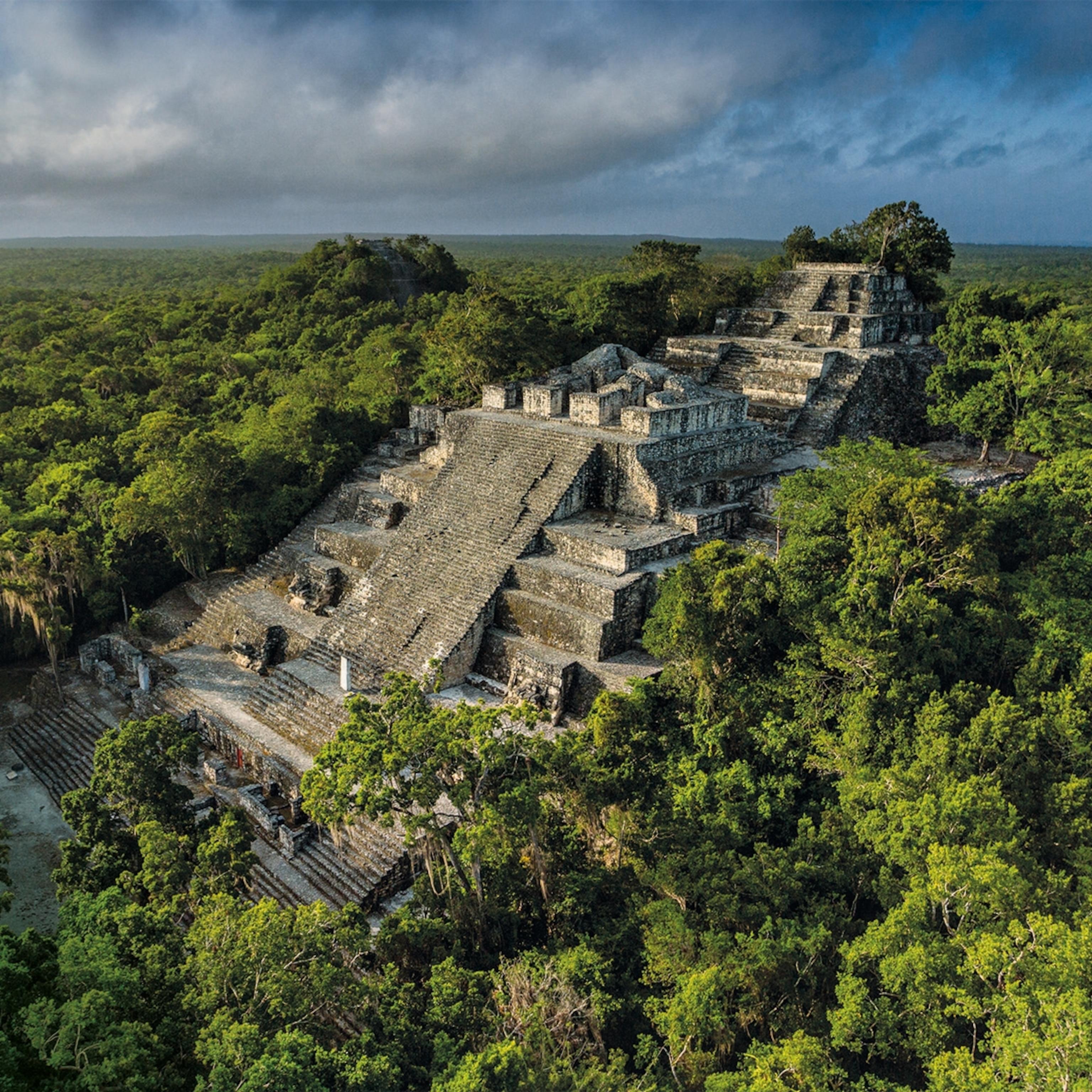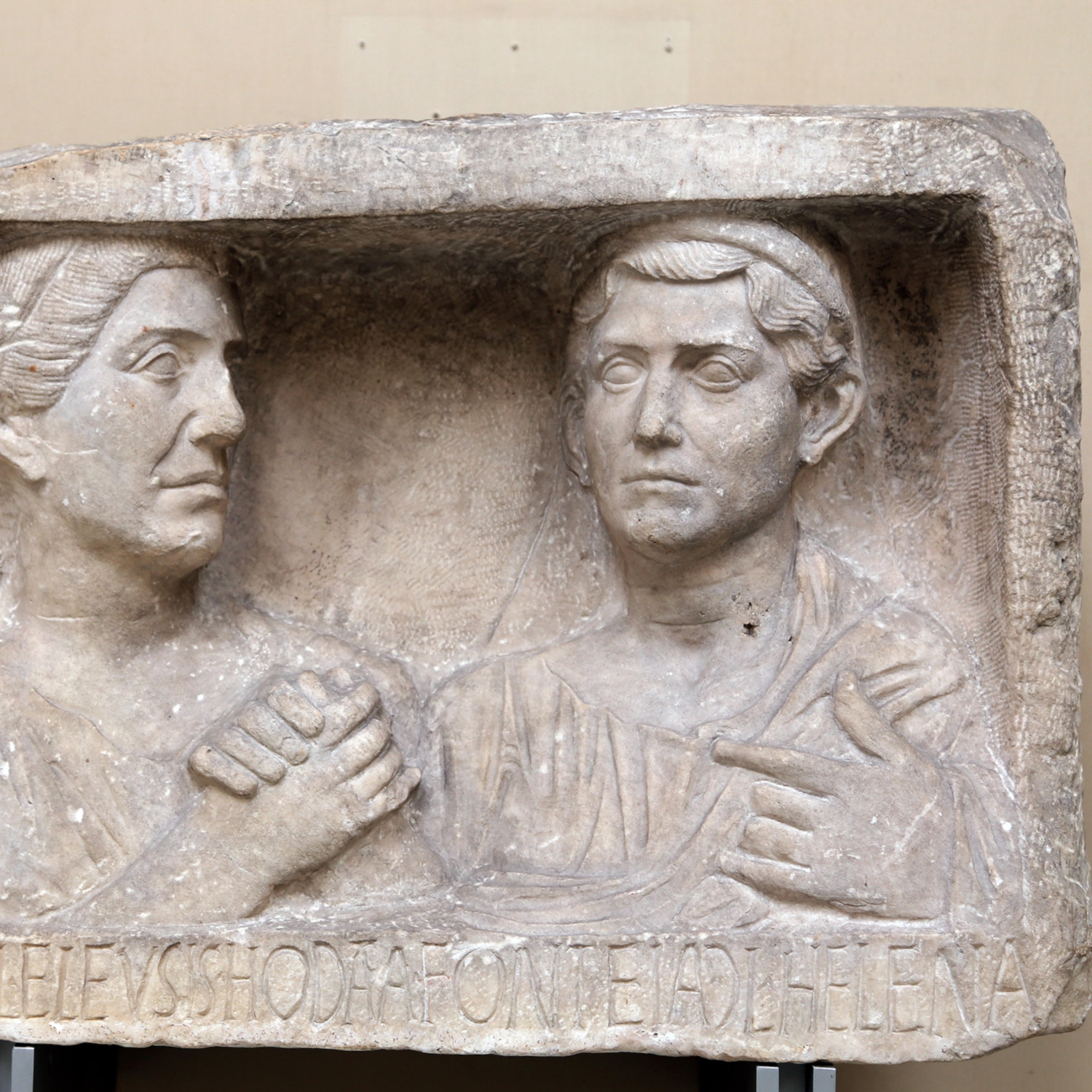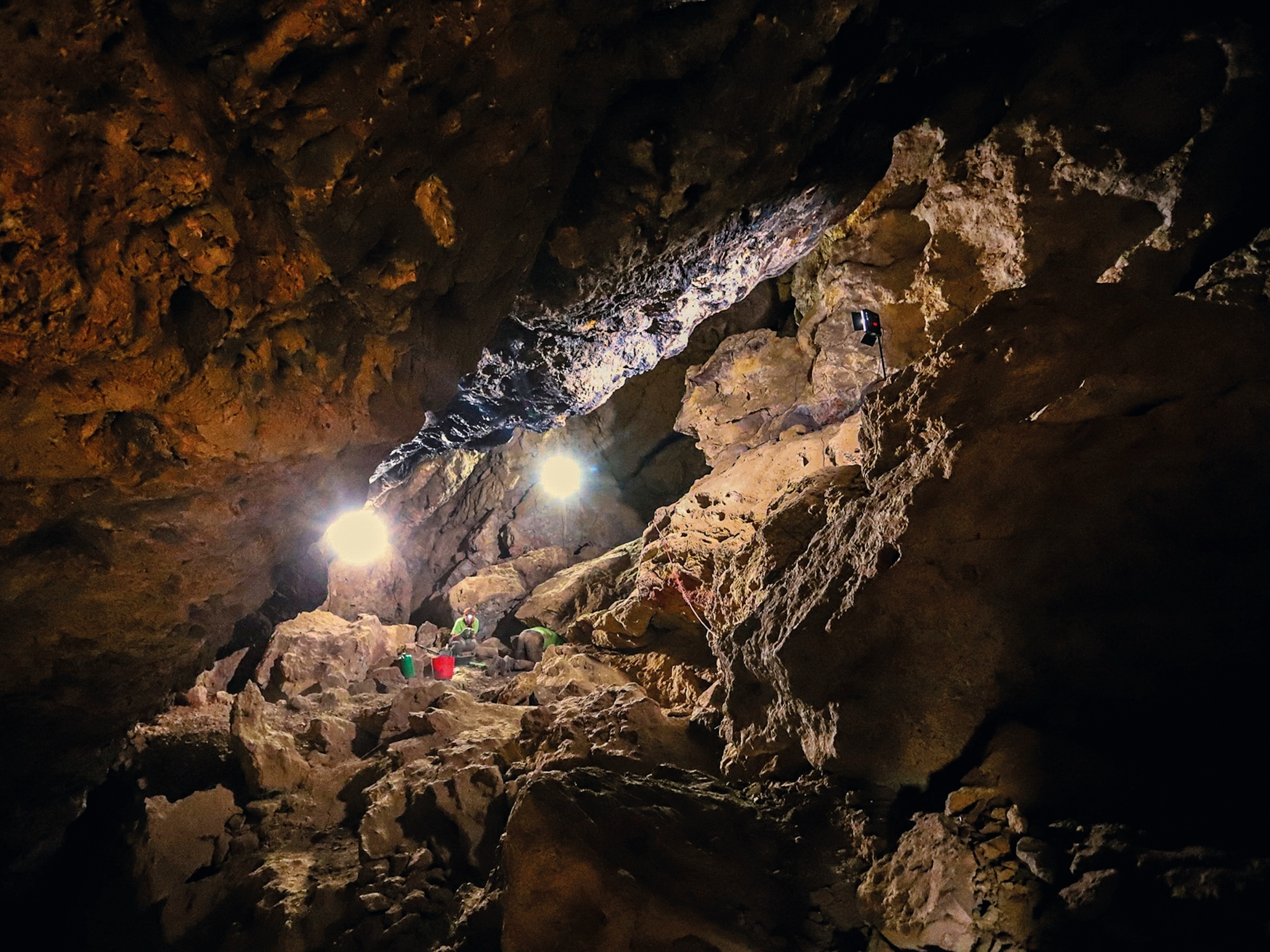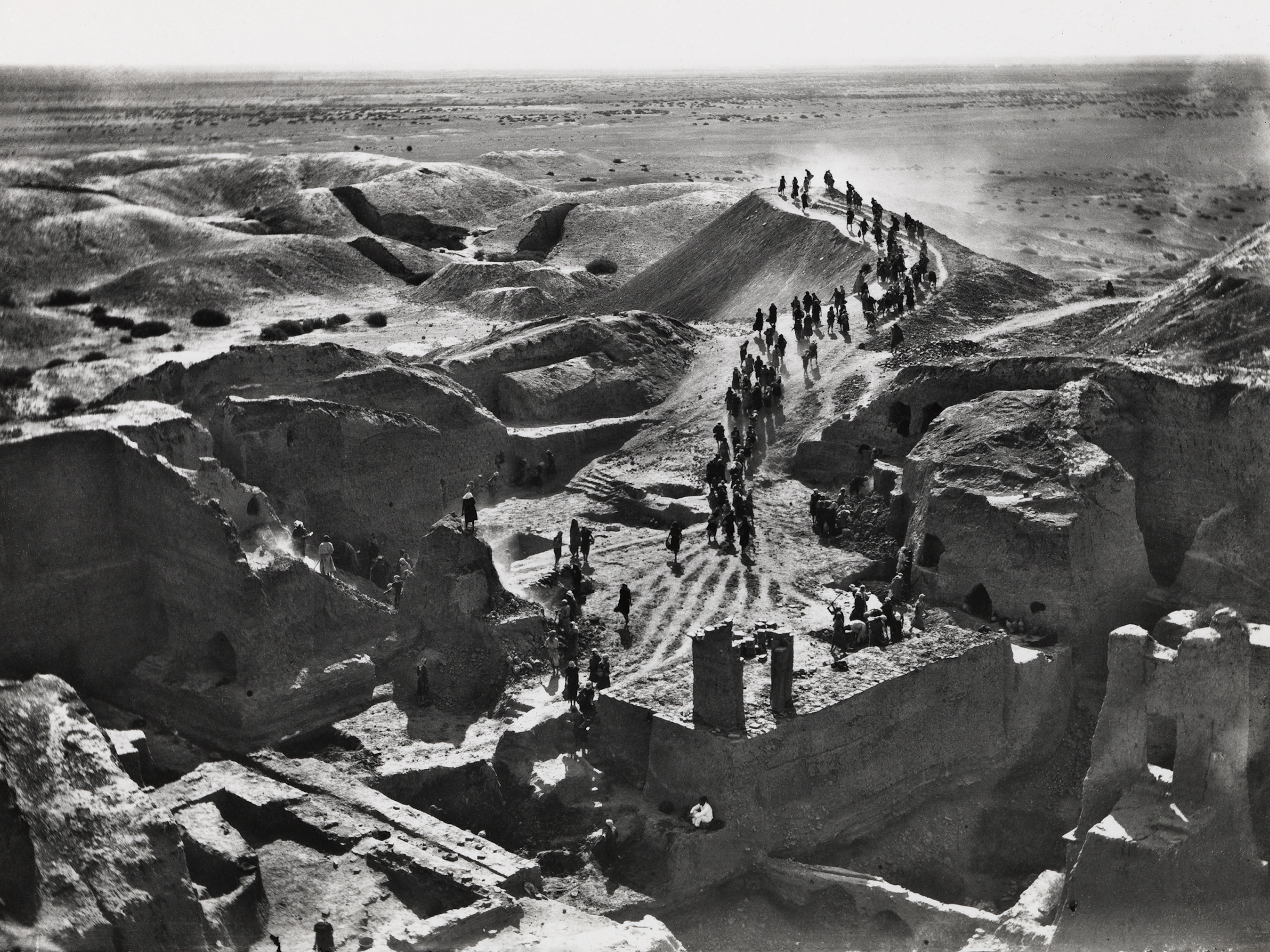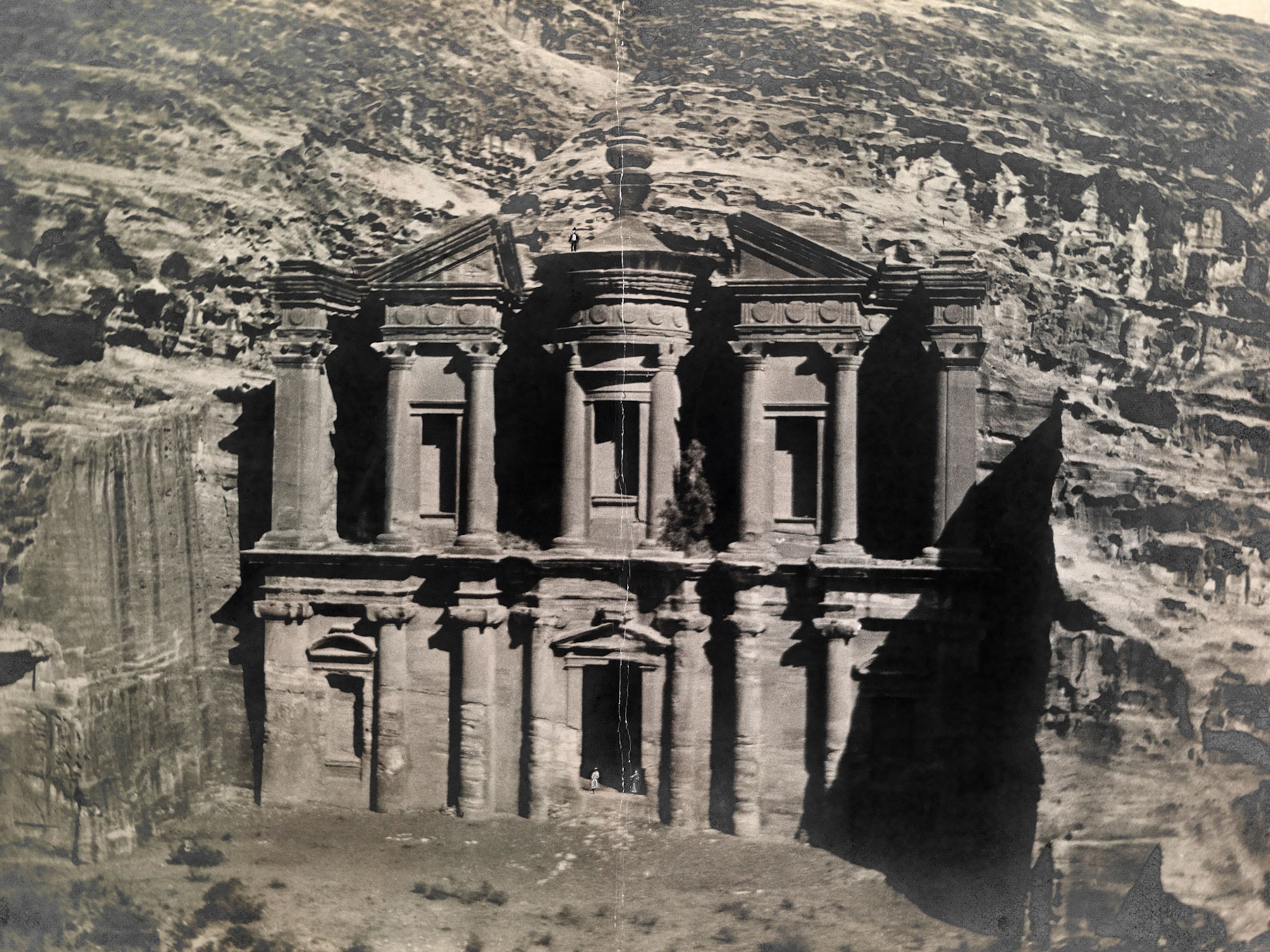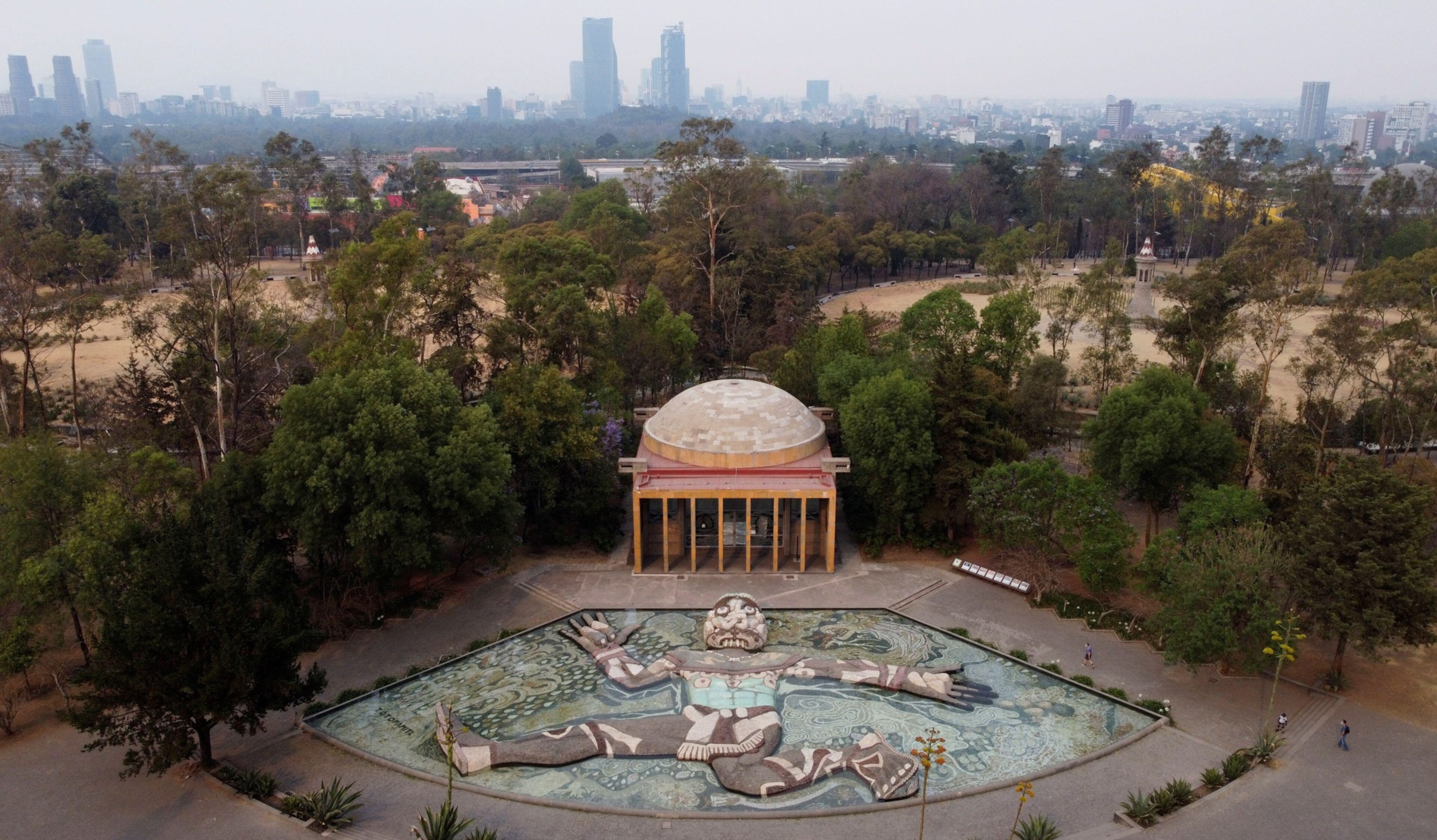
Giant sculpture of Aztec god makes a big statement about Mexican identity
Tlaloc Fountain, featuring work by muralist Diego Rivera, captures the role of art in Mexican history and culture.
Mexico City, Mexico — Deep in a barely-seen patch of Chapultepec Park, so remote that taxi drivers, balloon sellers, and kids racing scooters may not know it’s there, a giant effigy of a god sprawls in a green pool, spitting rain into the sky. It’s Tlaloc, god of water. All powers good and dangerous flow from this god, so old that he was worshipped before the Aztecs gave him this name—and so huge that he’s visible from airplanes approaching Mexico City’s Benito Juárez International Airport.
Even lying down, as he is depicted in this 100-foot pool, Tlaloc is monumental. Maybe frenzied, maybe ecstatic, he is frozen mid-stride. On his body, mosaics map symbols of Mexico’s myth and history. On his head, not one but two faces stare out: one into the heavens and the other, on the crown of his head, spewing water toward a tiny building a few steps away. He is guardian of a 70-year-old complex that also includes a neoclassical temple and a once-submerged fresco by Mexico’s most famous muralist.
The Water Garden Museum, as this strange complex is known, was created between 1950-52 by the iconic socialist artist Diego Rivera, commissioned by Mexico’s government. Built to celebrate a towering feat of mid-century engineering, its message is, if anything, more pressing now as the country commemorates its quincentennial. In an ideal society, this site declares, a country’s history and its present, its citizens, art, and government, its natural world and its scientists, all must be partners.
His body is meant to resemble the outline of the mountains where Tlaloc was worshipped.
Jeff Bale, essayist
I first visited Tlaloc at the suggestion of my friend Wesley Bocxe, who spent much of his career in Mexico City, his adopted home. “You need to see this,” he said. My teenage twins and I were there for our yearly trip to Mexico City, where my mom grew up in the 1930s. Some of my earliest memories are from Chapultepec, the biggest city park in the Americas. Fifty years later, vendors are stilling sell mangos sliced into the shape of rosebuds, and the melancholy carousel tunes seem to warn that even the cheeriest childhood memories one day may become bittersweet.
It was here, too, in a colonial castle-turned-military-school, that six young cadets called the Niños Héroes—heroic boys—are said to have leapt to their deaths in 1847 rather than surrender to invading American troops. I remember my mother telling me how, when she was a schoolgirl, teachers would read the boys’ names at assemblies. Only the top students got to answer for them: “Presente!” Yet, surprisingly, few of my Mexican friends had ever heard of the Fuente de Tláloc—Tlaloc Fountain. School trips and family outings drew them to other parts of the park; even now, few signs lead the way here.
There are a few reasons for this obscurity. In the tradition of sacred spots built on volcanoes or sulfuric cracks in the earth, both Tlaloc and the adjoining Cárcamo de Dolores—or pumping station—occupy an enormously dynamic ecological site. Both perch at the end point of a vast aqueduct that channels water from the River Lerma, Mexico’s longest river, and redistributes it to Mexico City. “Obviously, you have to keep that water clean,” says Kathryn O’Rourke, a professor of Mexican art and architecture at Trinity University. “So not drawing the public too much to this place is really important.”
But the art’s very distinctiveness also contributes to its low profile, says Aglaé Fragoso Hernández, a spokewoman for the nonprofit Probosque Chapultupec, which helped restore the Tlaloc fountain. Because Rivera’s creation was part of a working municipal water source, it often lacked proper care or publicity. “Because it’s a hydraulic project, it didn’t get support and maintenance from necessary cultural sources,” she explained. “So it’s suffered from various periods of abandonment and deterioration over the years.”
If Tlaloc can be hard to find, however, he still successfully strikes awe into visitors who happen upon him. In essays, articles, and conversations, I’ve noticed, the single most common word about this monument to the water god is “astounding.”
Water—and its power—have defined life for Mexico City over millennia.
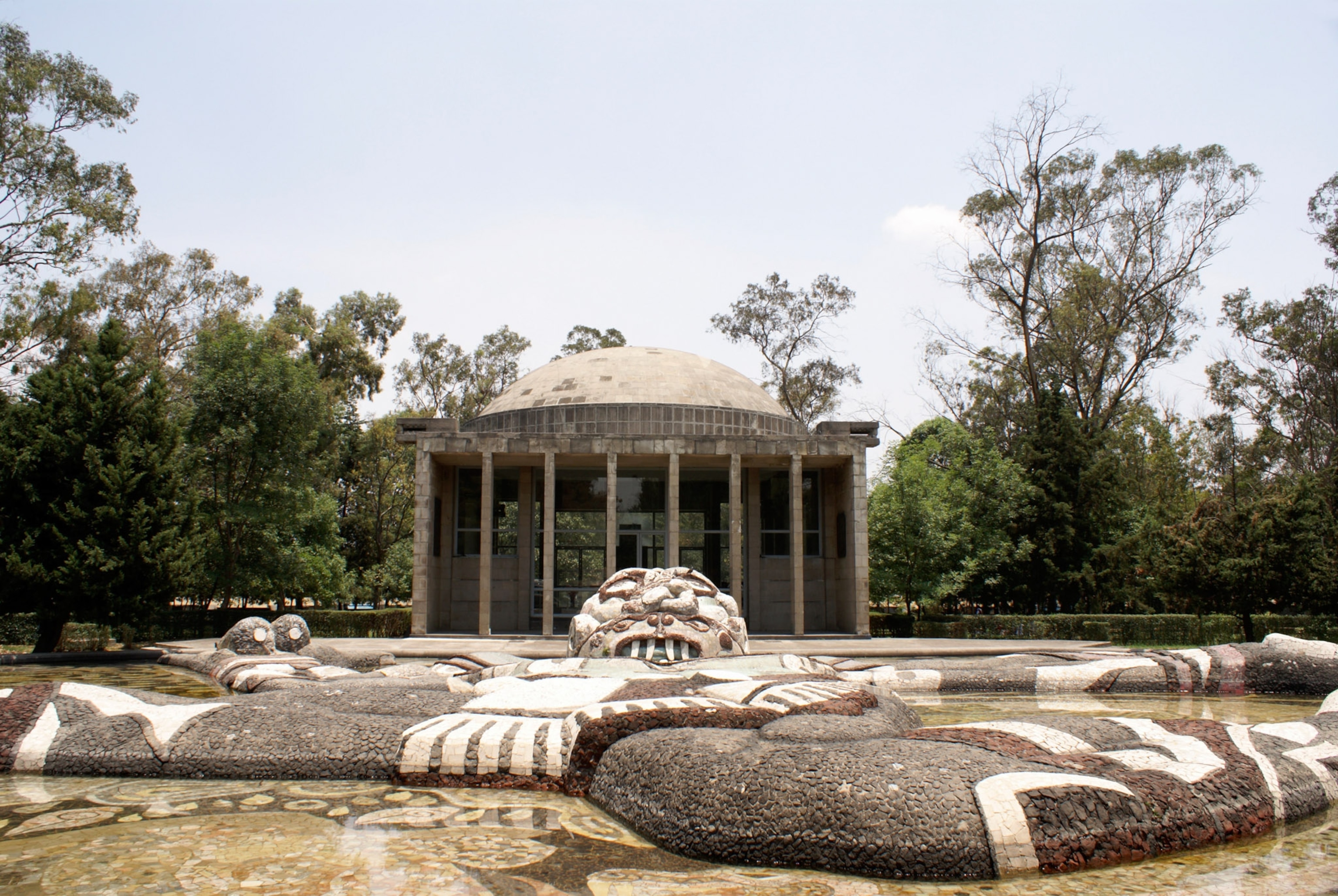
A sacred and defining force
Water—and its power—have defined life for Mexico City over millennia. Before Spanish conquistador Hernan Cortés arrived in 1519, in fact, the city actually was aquatic: Called Tenochtitlan, it sat on an island in a vast lake fretted with causeways and speckled with islands where residents raised vegetables, flowers, and maize—the empire’s sacred staple food, entirely dependent on adequate rain.
When the Spaniards arrived, they marveled at the city’s sophisticated hydraulic engineering—and then, over the course of centuries, worked to drain the lake on which it sat. The effort left immense ecological problems, including floods, sinking buildings, and dwindling water, that plague Mexico to this day. The city’s demand for water skyrocketed in the 1930s and 1940s, when wartime demand for Mexican products exploded the economy, industry, and population.
That’s why, in 1942, the government of this ancient city devised a 20th century solution: a 40-mile aqueduct from the Río Lerma to Mexico City. It would take eight years, and the deaths of no fewer than 39 workers, to channel these waters from the mountains into the thirsty capital. The aqueduct terminated here in this quiet corner of Chapultepec, where four reservoirs redirected the water through pumps to separate quadrants.
When the project was finished, its implications for Mexico were so enormous that the pump station’s designers tapped the country’s most famous muralist to honor its engineers. Within two years, 64-year-old Rivera delivered a wild visual web of references to water, science, evolution, and Mexican history—starting with the statue of Tlaloc and culminating in a lavish indoor underground fresco, attended by the sound of coursing water.
So why is this multisensory artwork barely known? One major reason is its very innovation. When Rivera painted his underwater mural, he used polystyrene-based paint. At first it worked. The first visitors saw Rivera’s imagery undulating behind the movements of Mexico’s longest river.
Over time, though, that water damaged the painting. Engineers rerouted the water, but neglect and Mexico’s perennial seismic turbulence took a toll. By the turn of the millennium, the damage was bad enough that the entire complex was shuttered for a decade. Finally, with the help of the nonprofit Probosque Chapultepec, Tlaloc and the mural El Agua, Origen de la Vida—Water, The Origin of Life—were restored in 2010 and Mexico’s temple to ancient gods and modern science reopened.

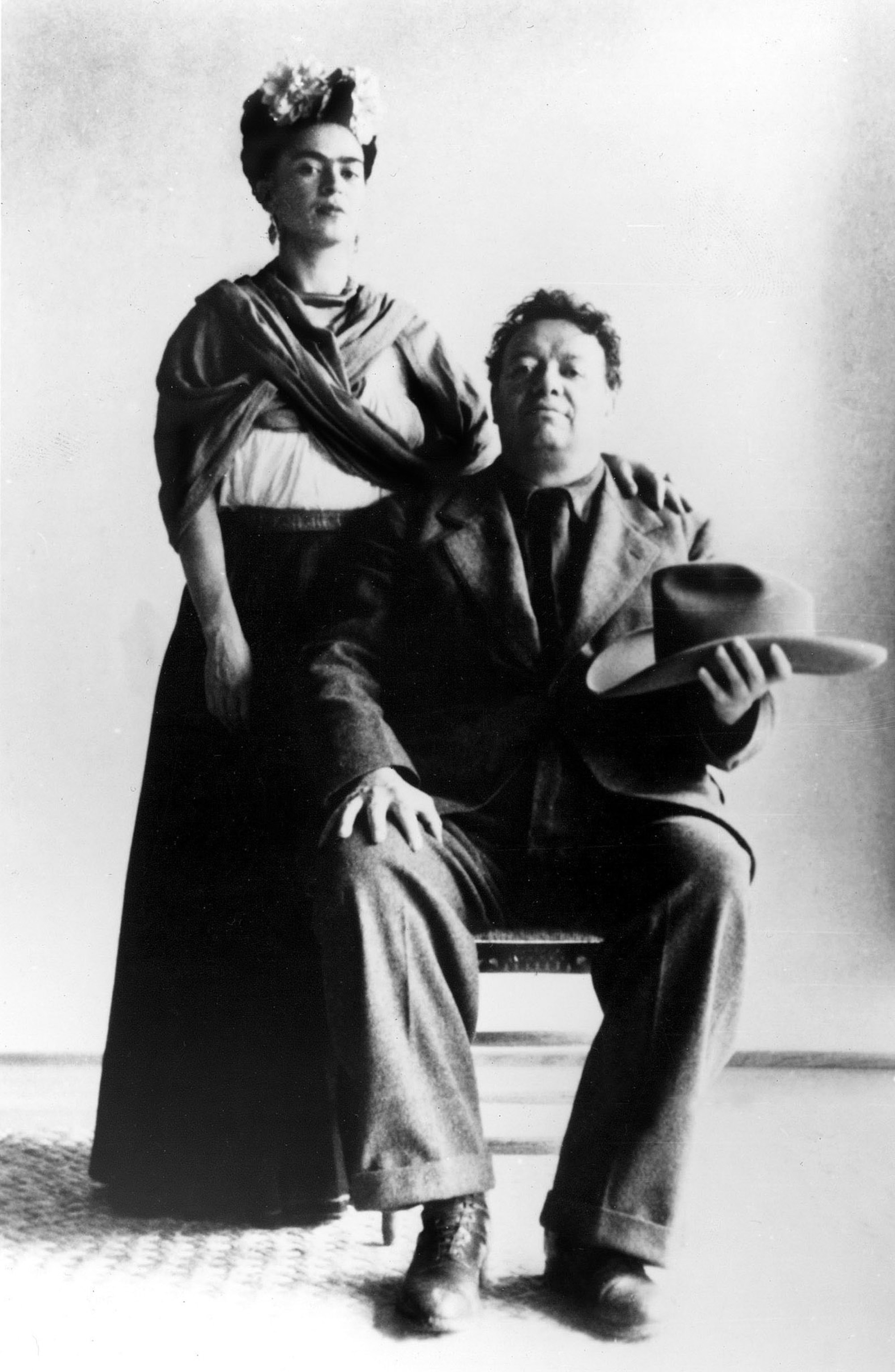
The sound of rushing water
I heard Tlaloc before I truly saw him. Rain—a heavy, Mexican rainy season-style downpour—pattered ceaselessly from the statue’s skyward-facing mouth into the water around him. I’d arrived in late afternoon on a spring day, and Eduardo, the young taxi driver who ferried me here, got out with me. He’d never heard of the Tlaloc statue, he said, but he’d always revered ancient Mexican cosmology and engineering. As we approached the monument, he showed me his forearm, covered entirely with an intricate tattoo of Coatlicue, Aztec goddess of fertility. “I believe in the Virgin and the saints,” he said. “But I was raised by my mother, who pushed me to finish school, and I have sisters, two daughters, and a wife. Where I’m from in the countryside, women aren’t valued for more than serving men. I have this tattoo to honor women and all they can do.”
Eduardo was also very familiar with Tlaloc. Tapping his phone, he summoned a TV documentary about the famous arrival of another Tlaloc to this part of Mexico: a dust-colored 168-ton monolith hauled in 1964 from the village of Coatlinchan, where it had resided for centuries, to the nearby Museum of Anthropology. Interspersed with vintage footage of the statue’s progress through throngs of fascinated observers in Mexico City are images of Coatlinchan’s villagers, swathed in shawls and work clothes, looking stricken. “There is a profound sadness,” a TV commentator says in the news clip Eduardo shows me. On the day the monolith entered Mexico City, Mexicans still remember, the city was deluged with the worst rainstorm ever recorded for that time of year.
Water is the origin of life. It flows from Tlaloc. Literally and metaphorically, it has been channeled to humanity—led by Mexico’s workers and engineers.
Kathryn O’Rourke, Professor of Mexican art and architecture
But Rivera’s Tlaloc conveys another mood entirely. Rather than being a hostage, this god surges with barely-contained energy. His legs and arms flail as if caught in mid-leap across the earth, or in a frenzy of supernatural creation like a dancing god Shiva. All over his body, nubbled stone mosaics show symbols from Mexico’s past, including two sacred corncobs—the reason ancient Mexicans prayed so desperately for Tlaloc’s rainy benevolence.
Riveting as he is at eye level, however, Tlaloc was meant to be fully appreciable from airplanes. The spraying water, essayist Jeff Bale pointed out, “mimics rain and connects water with the air. His body is meant to resemble the outline of the mountains where Tlaloc was worshipped.” On Tlaloc’s left sandal is the image of an eagle poised on a cactus, overlooking a river. It’s the origin image of Mexico City itself, which Aztecs traced to an eagle that led early wanderers to the future Tenochtitlan.
This particular image, it turned out, also occupies prominent space on the heavily tattooed arm of 38-year-old Oscar Huerta, an office worker who stumbled upon Tlaloc the same afternoon I was there. He was on an outing with his wife, 38-year-old Sandra Itzel, and their son Eric Ramses Huerta, six.
“We just found this place by accident,” Huerta says. Indulging me, he stretched out his arm, with its almost identical imagery, in front of Tlaloc’s foot. Itzel stretched out her own arm, meticulously tattooed with the image of a Mayan governor from the architectural site Palenque. “Our friends are tour guides and anthropologists and they’ve helped inculcate us with love for our culture,” Itzel says. “These tattoos, for me, are part of being Mexican. We’re also Catholic. But syncretism is part of being Mexican.”

Art and national pride
Rivera helped popularize these images as a vehicle for national pride. He also was authentically fueled by them artistically. In the 1920s and 1930s, Rivera’s murals helped lead a radical renewal of interest in the indigenous cultures that had been brutalized and marginalized since the Spanish conquest. Over the years, these depictions of indigenous people and their lives have been sharply reexamined. But with his peers, Rivera helped advance a new understanding of Mexico as a country shaped equally by indigenous and European cultures.
At the time he created his Tlaloc, Rivera himself was being re-evaluated. His murals, originally subversive, gradually became a part of the Mexican government’s national project to create a unified Mexican identity. By 1950, “Rivera’s star had kind of fallen,” art historian O’Rourke says. In the 1920s muralism had been radical, with caricatures and critiques of political figures. By the 1950s critics were complaining that the genre—and Rivera, by taking on this and other public commissions—had been coopted by the state.
At the same time, though, Rivera had become more experimental, more technically daring, than at any previous moment in his career. He began to reference not only indigenous people, as he had for years, but their architecture, theology, even interactions with the earth.
Even more groundbreaking was his statue’s design, fully visible only from airplanes. This perspective, impossible until the early 20th century, had recently revealed for the first time the otherworldly scale of other indigenous landscape art, including Mexico’s pyramids and Peru’s Nazca lines.“There wasn’t such a thing as land art in the 1950s,” O’Rourke says. “With this reference to indigenous architecture, artists like Rivera were trying to resuscitate a recognition of what a modern nation can be: It cannot just be the tiny sliver of the nation that’s white.”
'Water is the origin of life'
To fully appreciate the relevance of that worldview today, though, required a look indoors—at the river’s underground crossroads.
For a second time, I heard the monument before I fully saw it. In the small pavilion overlooking the water god, weird, wavering sounds, like a theremin, vibrated the air. They emanated from a pipe organ, with familiar-enough looking tubes on a wall, but activated by water currents and solar energy (recent repairs to the organ have been stalled due to the COVID-19 pandemic). The organ, created by artist Ariel Guzik as part of the 2010 renovation, replaces the original rush of the river with eerie harmonies triggered by water currents, sun, and wind.
“It’s an instrument that plays water,” Eduardo Vazquez Martin, executive coordinator of Mandato del Antiguo Colegio de San Ildefonso, says in a recorded lecture. In Guzik’s sound installation, he says, “the organ is connected to a complex system … that captures the movement of the water and reproduces it in sounds. The water returns as a song—as music. It’s restored as a central element.”
Far down below the protective railing, the reservoir floor swarms with painted microorganisms as if under a vast microscope. The organisms are meant to suggest the emergence of life from a primordial soup. Radiating up the walls are image upon image of other life forms: amoebas, fish, snakes and eels, frantically wiggling toward the terrestrial world. Above them, workers, Indigenous farmers, bourgeois ladies, even house pets, are shown collecting and savoring Earth’s life-giving water. Images of an African man and a woman with Indigenous features represent humans’ shared ancestors.
Finally, lining the top of this phantasmagoria, stand the scientists. Dressed in hard hats, work jackets, or coats and ties, leaning over a blueprint, these are the engineers who made Mexico’s miraculous water system a reality. Arrayed like apostles, they represent a young democracy at one of the most optimistic points in its history.
“This painting is a celebration of modern science,” O’Rourke says. “When you’re in that building and you look out, you see the head of Tlaloc. And that’s when you start to make sense of both the mosaics outside and the painting inside. Water is the origin of life. It flows from Tlaloc. Literally and metaphorically, it has been channeled to humanity—led by Mexico’s workers and engineers.”
It was late afternoon, time to leave. As the taxi drove away from Chapultepec, water from a summer shower sprayed into the air next to our tires. Watching Tlaloc slip away, I was struck by this fierce god’s endurance. Product of a distant past, he nevertheless embodies a duality that is still perfectly current: the life-and-death powers of nature—and our urgent need to respect both.
Claudia Kolker is the author of The Immigrant Advantage: What We Can Learn From Newcomers To America About Health, and Happiness and Hope, which was recently re-released as an audiobook. She is the editor of the ideas magazine at Rice Business School.

